Laser Assisted Size Reduction of Gold (Au) Particles onto a Titanium (Ti) Substrate Surface
Abstract
:1. Introduction
2. Materials and Methods
2.1. Laser Micromachining
2.2. Microscopic Observations
3. Results
4. Discussion
5. Conclusions
- Results of power—depth measurements indicates that above 13.2 mW the depth of the obtained grove increases exponentially, while under this power the increase is linear
- 355 nm picosecond laser with power of 22 mW causes obtaining grove depth of 7 and 0.8 μm for 400 Hz and single laser irradiation, respectively
- The Au NPs formation (mainly between 15 to 30 nm) and partial remelting into matrix is possible for proposed in experiment laser powers and allowed obtainment of nano Au particles
- There seems to be no strict relationship between used power and particle size distribution of gold onto Ti, probably due to too low energy to excite titanium enough resulting from difference in Ti and Au melting point temperatures.
- The results show clear bimodal distribution of particle size
- EDS analysis confirmed presence and local distribution shape in laser irradiated area changing with the distance from laser source
Author Contributions
Funding
Conflicts of Interest
References
- Feynman, R.P. Plenty of Room at the Bottom; American Physical Society: Pasadena, CA, USA, 1959. [Google Scholar]
- Bayda, S.; Adeel, M.; Tuccinardi, T.; Cordani, M.; Rizzolio, F. The History of Nanoscience and Nanotechnology: From Chemical-Physical Applications to Nanomedicine. Molecules 2019, 25, 112. [Google Scholar] [CrossRef] [PubMed] [Green Version]
- Górka, J.; Czupryński, A.; Żuk, M.; Adamiak, M.; Kopyść, A. Properties and Structure of Deposited Nanocrystalline Coatings in Relation to Selected Construction Materials Resistant to Abrasive Wear. Materials 2018, 11, 1184. [Google Scholar] [CrossRef] [PubMed] [Green Version]
- Chang, Y.-Y.; Zhang, J.-H.; Huang, H.-L. Effects of Laser Texture Oxidation and High-Temperature Annealing of TiV Alloy Thin Films on Mechanical and Antibacterial Properties and Cytotoxicity. Materials 2018, 11, 2495. [Google Scholar] [CrossRef] [PubMed] [Green Version]
- Frostevarg, J.; Olsson, R.; Powell, J.; Palmquist, A.; Brånemark, R. Formation Mechanisms of Surfaces for Osseointegration on Titanium Using Pulsed Laser Spattering. Appl. Surf. Sci. 2019, 485, 158–169. [Google Scholar] [CrossRef]
- Hatzikiriakos, S.G.; Moradi, S.; Kamal, S. Superhydrophobic Laser-Ablated Stainless Steel Substrates Exhibiting Cassie–Baxter Stable State. Surf. Innov. 2015, 3, 151–163. [Google Scholar] [CrossRef]
- Woźniak, A.; Adamiak, M.; Chladek, G.; Bonek, M.; Walke, W.; Bialas, O. The Influence of Hybrid Surface Modification on the Selected Properties of CP Titanium Grade II Manufactured by Selective Laser Melting. Materials 2020, 13, 2829. [Google Scholar] [CrossRef]
- Kołodziejczak, P.; Golański, D.; Chmielewski, T.; Chmielewski, M. Microstructure of Rhenium Doped Ni-Cr Deposits Produced by Laser Cladding. Materials 2021, 14, 2745. [Google Scholar] [CrossRef]
- Wang, C.; Suder, W.; Ding, J.; Williams, S. Wire Based Plasma Arc and Laser Hybrid Additive Manufacture of Ti-6Al-4V. J. Mater. Process. Technol. 2021, 293, 117080. [Google Scholar] [CrossRef]
- Bialas, O.; Lis, M.; Woźniak, A.; Adamiak, M. Laser Superficial Fusion of Gold Nanoparticles with PEEK Polymer for Cardiovascular Application. Materials 2021, 14, 971. [Google Scholar] [CrossRef]
- Chmielewski, T.; Hudycz, M.; Krajewski, A.; Sałaciński, T.; Skowrońska, B.; Świercz, R. Structure Investigation of Titanium Metallization Coating Deposited onto AlN Ceramics Substrate by Means of Friction Surfacing Process. Coatings 2019, 9, 845. [Google Scholar] [CrossRef] [Green Version]
- Laing, M. Melting Point, Density, and Reactivity of Metals. J. Chem. Educ. 2001, 78, 1054. [Google Scholar] [CrossRef]
- Podor, R.; Pailhon, D.; Ravaux, J.; Brau, H.-P. Development of an Integrated Thermocouple for the Accurate Sample Temperature Measurement During High Temperature Environmental Scanning Electron Microscopy (HT-ESEM) Experiments. Microsc. Microanal. 2015, 21, 307–312. [Google Scholar] [CrossRef]
- Lisiecki, A. Study of Optical Properties of Surface Layers Produced by Laser Surface Melting and Laser Surface Nitriding of Titanium Alloy. Materials 2019, 12, 3112. [Google Scholar] [CrossRef] [Green Version]
- Balazic, M.; Kopac, J.; Jackson, M.J.; Ahmed, W. Review: Titanium and Titanium Alloy Applications in Medicine. IJNBM 2007, 1, 3. [Google Scholar] [CrossRef]
- Chaanine, A.H.; Pinney, S.P. Mechanical Circulatory Support as a Bridge to Heart Transplantation. In Heart Failure; Eisen, H., Ed.; Springer London: London, UK, 2017; pp. 639–663. ISBN 978-1-4471-4218-8. [Google Scholar]
- de Puig, H.; Cifuentes Rius, A.; Flemister, D.; Baxamusa, S.H.; Hamad-Schifferli, K. Selective Light-Triggered Release of DNA from Gold Nanorods Switches Blood Clotting On and Off. PLoS ONE 2013, 8, e68511. [Google Scholar] [CrossRef] [PubMed] [Green Version]
- Wijaya, A.; Schaffer, S.B.; Pallares, I.G.; Hamad-Schifferli, K. Selective Release of Multiple DNA Oligonucleotides from Gold Nanorods. ACS Nano 2009, 3, 80–86. [Google Scholar] [CrossRef] [PubMed]
- Huschka, R.; Zuloaga, J.; Knight, M.W.; Brown, L.V.; Nordlander, P.; Halas, N.J. Light-Induced Release of DNA from Gold Nanoparticles: Nanoshells and Nanorods. J. Am. Chem. Soc. 2011, 133, 12247–12255. [Google Scholar] [CrossRef] [Green Version]
- Ajdari, N.; Vyas, C.; Bogan, S.L.; Lwaleed, B.A.; Cousins, B.G. Gold Nanoparticle Interactions in Human Blood: A Model Evaluation. Nanomed. Nanotechnol. Biol. Med. 2017, 13, 1531–1542. [Google Scholar] [CrossRef] [PubMed]
- Fan, J.H.; Hung, W.I.; Li, W.T.; Yeh, J.M. Biocompatibility Study of Gold Nanoparticles to Human Cells. In 13th International Conference on Biomedical Engineering; Lim, C.T., Goh, J.C.H., Eds.; IFMBE Proceedings; Springer: Berlin, Germany, 2009; Volume 23, pp. 870–873. ISBN 978-3-540-92840-9. [Google Scholar]
- Liu, K.; Zheng, Y.; Lu, X.; Thai, T.; Lee, N.A.; Bach, U.; Gooding, J.J. Biocompatible Gold Nanorods: One-Step Surface Functionalization, Highly Colloidal Stability, and Low Cytotoxicity. Langmuir 2015, 31, 4973–4980. [Google Scholar] [CrossRef]
- Gu, X.; Xu, Z.; Gu, L.; Xu, H.; Han, F.; Chen, B.; Pan, X. Preparation and Antibacterial Properties of Gold Nanoparticles: A Review. Environ. Chem. Lett. 2020. [Google Scholar] [CrossRef]
- Camilo, C.C.; de Souza, E.C.; Di Lorenzo, P.L.; de Almeida Rollo, J.M.D. Measurement of the Grain Boundary Energy of Commercially-Pure Grade 2 Titanium at High Temperature. RBEB 2011, 27, 175–181. [Google Scholar] [CrossRef] [Green Version]
- Standard Specification for Titanium and Titanium Alloy Bars and Billets. ASTM B348/B348M. Available online: https://www.astm.org/Standards/B348.htm (accessed on 3 January 2021).
- Sample preparation for electron-microscopy. Available online: https://Www.Leica-Microsystems.Com/ (accessed on 3 January 2021).
- Ortiz, R.; Basnett, P.; Roy, I.; Quintana, I. Picosecond Laser Ablation of Polyhydroxyalkanoates (PHAs): Comparative Study of Neat and Blended Material Response. Polymers 2020, 12, 127. [Google Scholar] [CrossRef] [PubMed] [Green Version]
- Shaheen, M.E.; Gagnon, J.E.; Fryer, B.J. Laser Ablation of Iron: A Comparison between Femtosecond and Picosecond Laser Pulses. J. Appl. Phys. 2013, 114, 083110. [Google Scholar] [CrossRef]
- Milovanović, D.S.; Petrović, S.M.; Shulepov, M.A.; Tarasenko, V.F.; Radak, B.B.; Miljanić, Š.S.; Trtica, M.S. Titanium Alloy Surface Modification by Excimer Laser Irradiation. Opt. Laser Technol. 2013, 54, 419–427. [Google Scholar] [CrossRef]
- Pyatenko, A.; Yamaguchi, M.; Suzuki, M. Mechanisms of Size Reduction of Colloidal Silver and Gold Nanoparticles Irradiated by Nd:YAG Laser. J. Phys. Chem. C 2009, 113, 9078–9085. [Google Scholar] [CrossRef]
- Inasawa, S.; Sugiyama, M.; Yamaguchi, Y. Bimodal Size Distribution of Gold Nanoparticles under Picosecond Laser Pulses. J. Phys. Chem. B 2005, 109, 9404–9410. [Google Scholar] [CrossRef]
- Kamat, P.V.; Flumiani, M.; Hartland, G.V. Picosecond Dynamics of Silver Nanoclusters. Photoejection of Electrons and Fragmentation. J. Phys. Chem. B 1998, 102, 3123–3128. [Google Scholar] [CrossRef]
- Shoji, M.; Miyajima, K.; Mafuné, F. Ionization of Gold Nanoparticles in Solution by Pulse Laser Excitation as Studied by Mass Spectrometric Detection of Gold Cluster Ions. J. Phys. Chem. C 2008, 112, 1929–1932. [Google Scholar] [CrossRef]
- Muto, H.; Miyajima, K.; Mafuné, F. Mechanism of Laser-Induced Size Reduction of Gold Nanoparticles As Studied by Single and Double Laser Pulse Excitation. J. Phys. Chem. C 2008, 112, 5810–5815. [Google Scholar] [CrossRef]
- Kutrovskaya, S.; Arakelian, S.; Kucherik, A.; Osipov, A.; Evlyukhin, A.; Kavokin, A.V. The Synthesis of Hybrid Gold-Silicon Nano Particles in a Liquid. Sci. Rep. 2017, 7, 10284. [Google Scholar] [CrossRef]
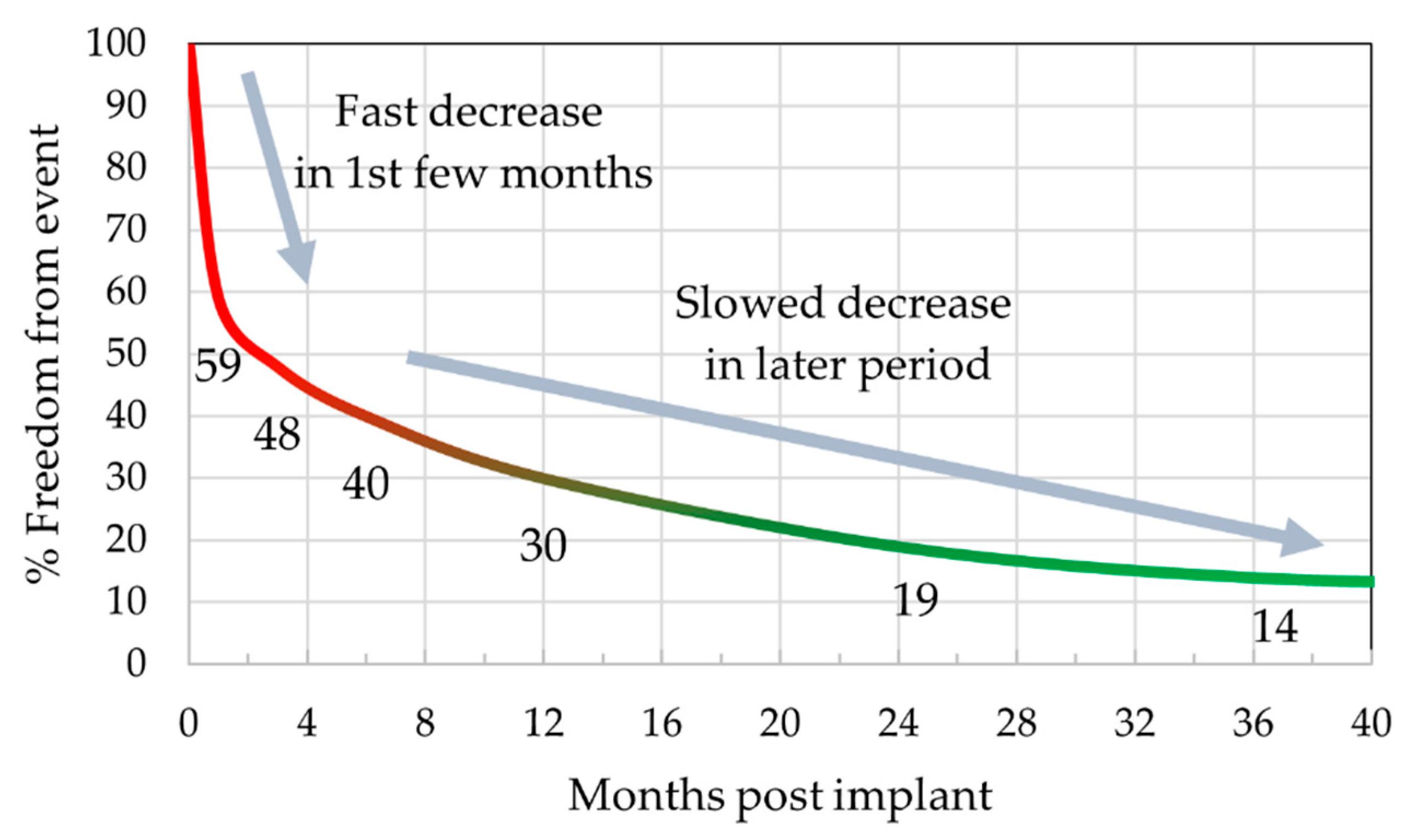


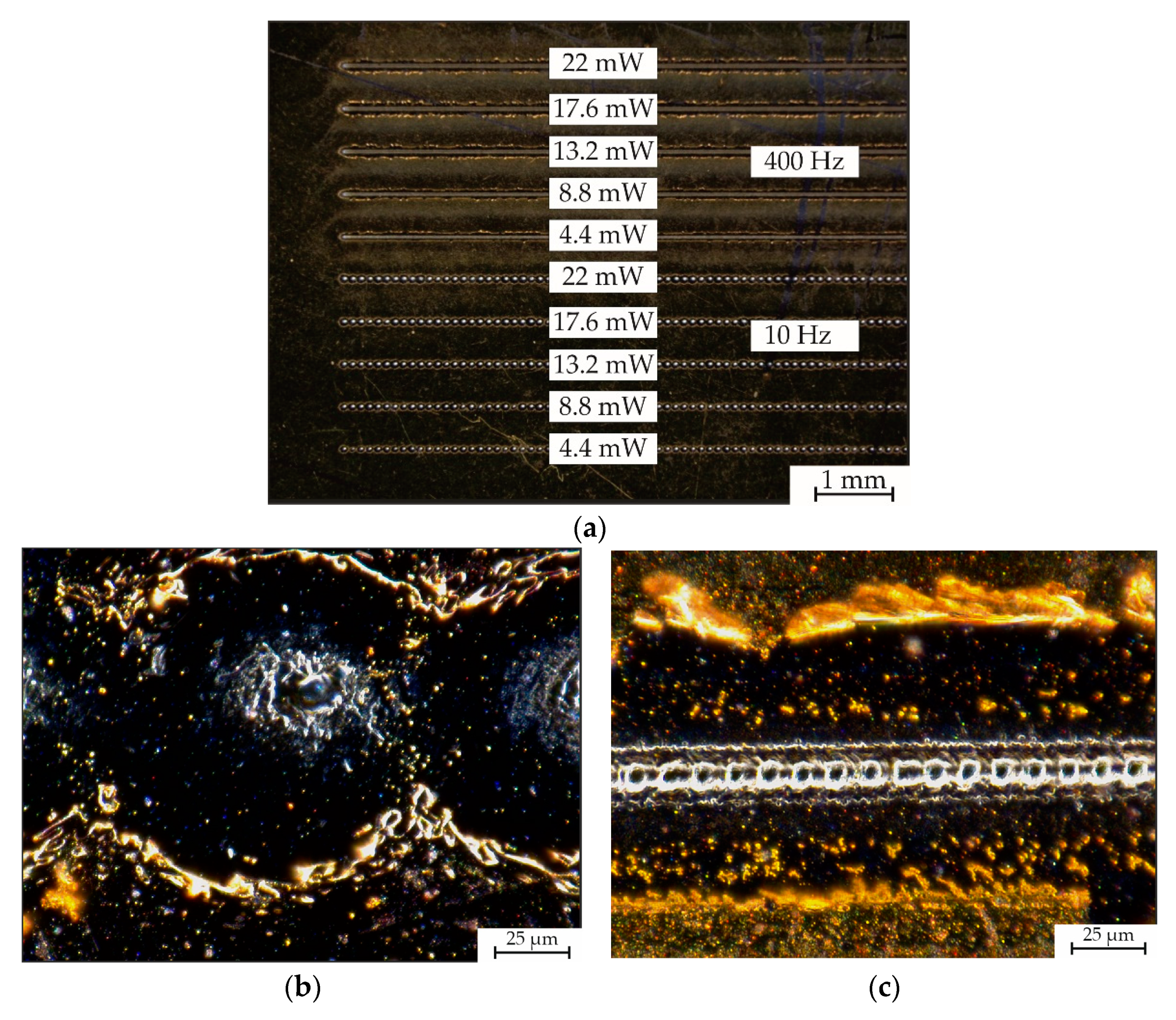
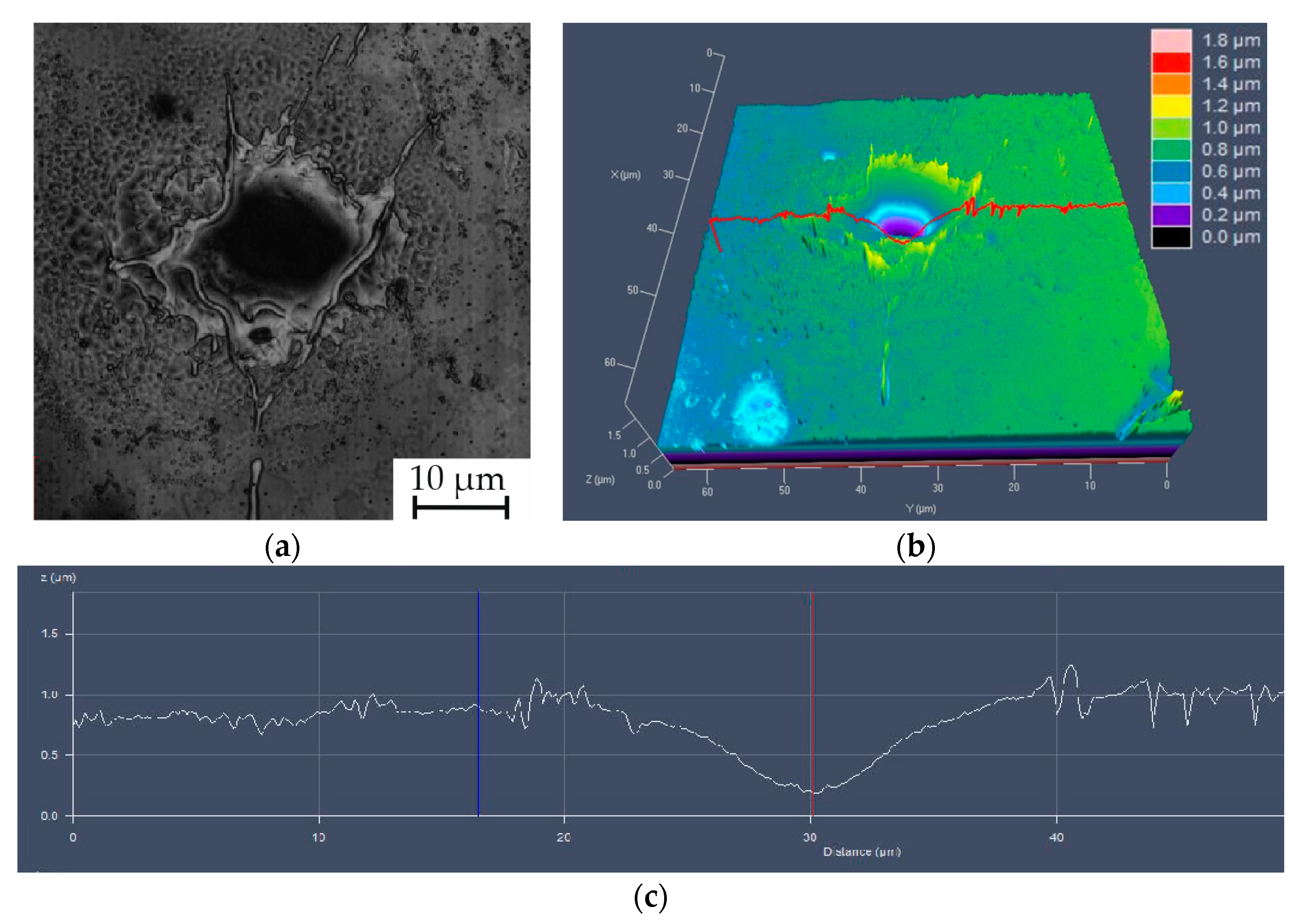
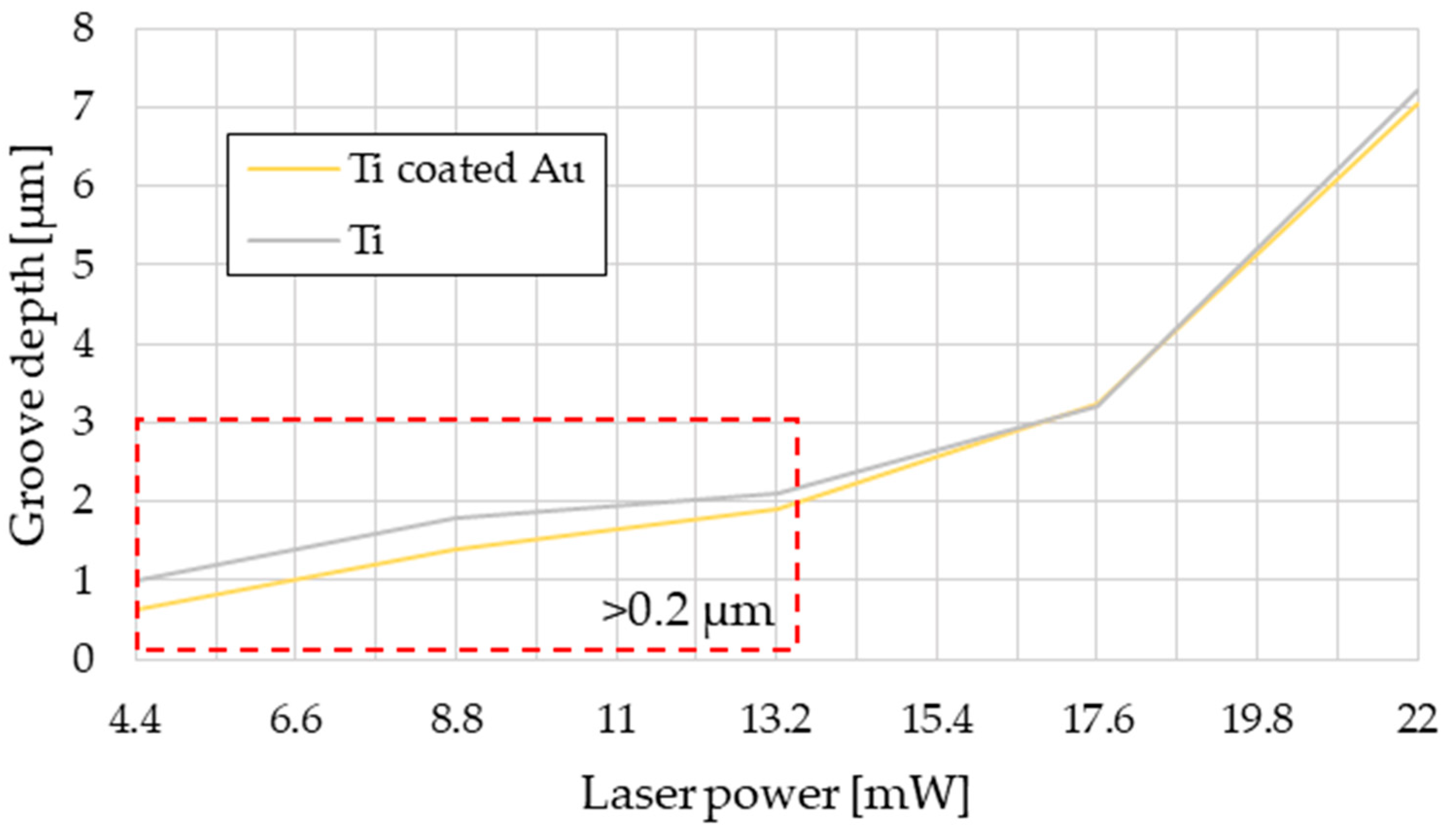
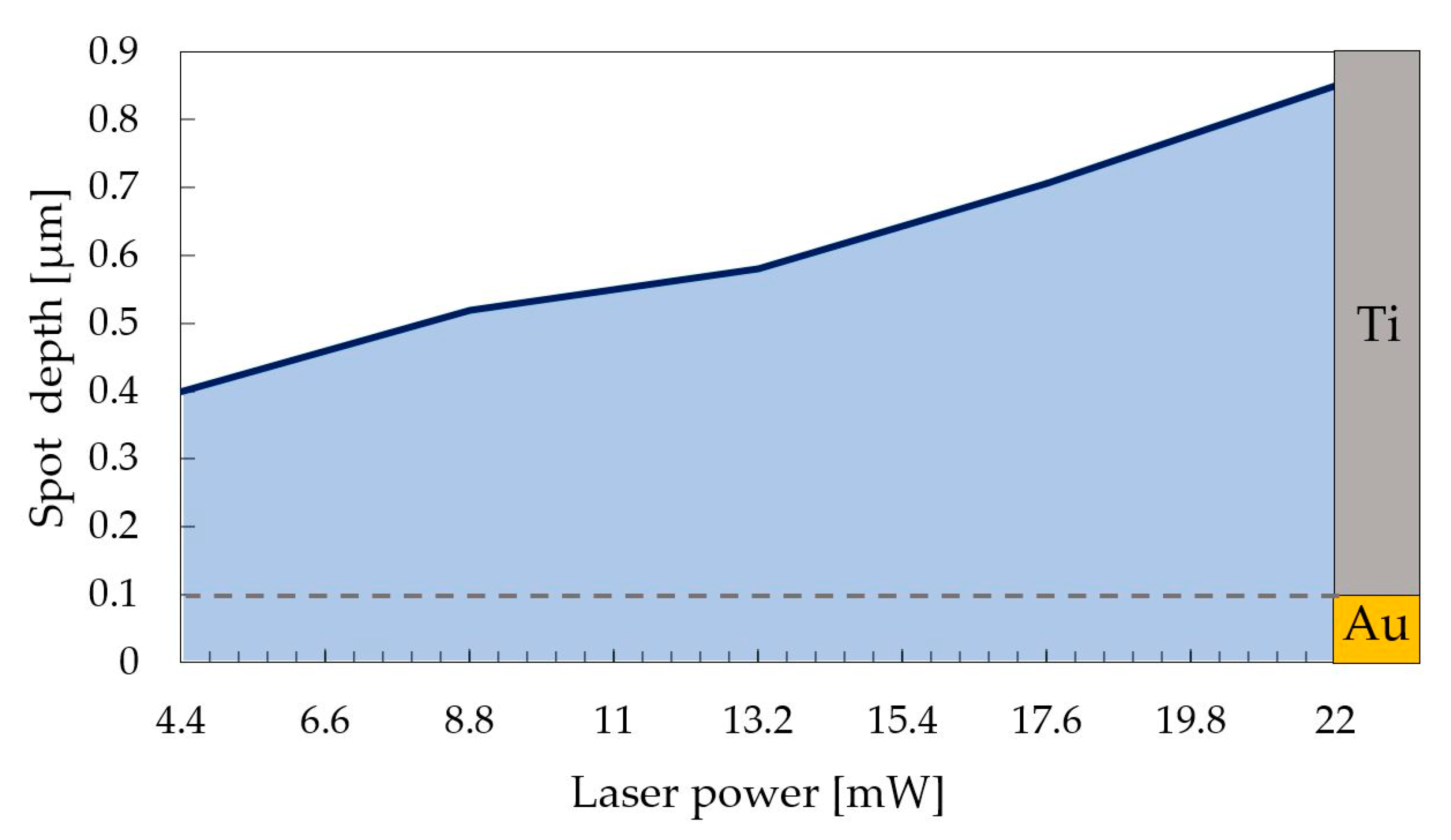

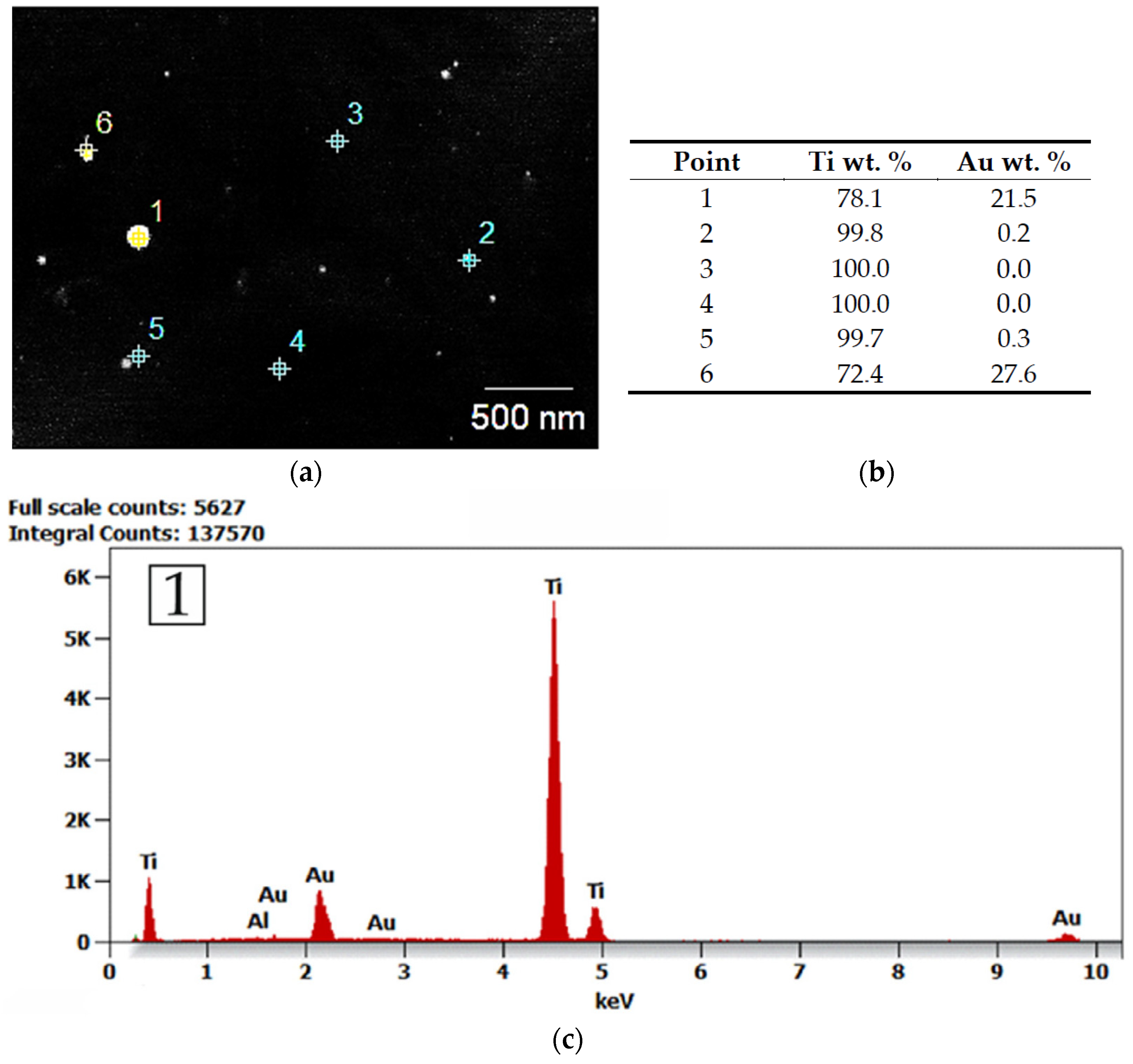

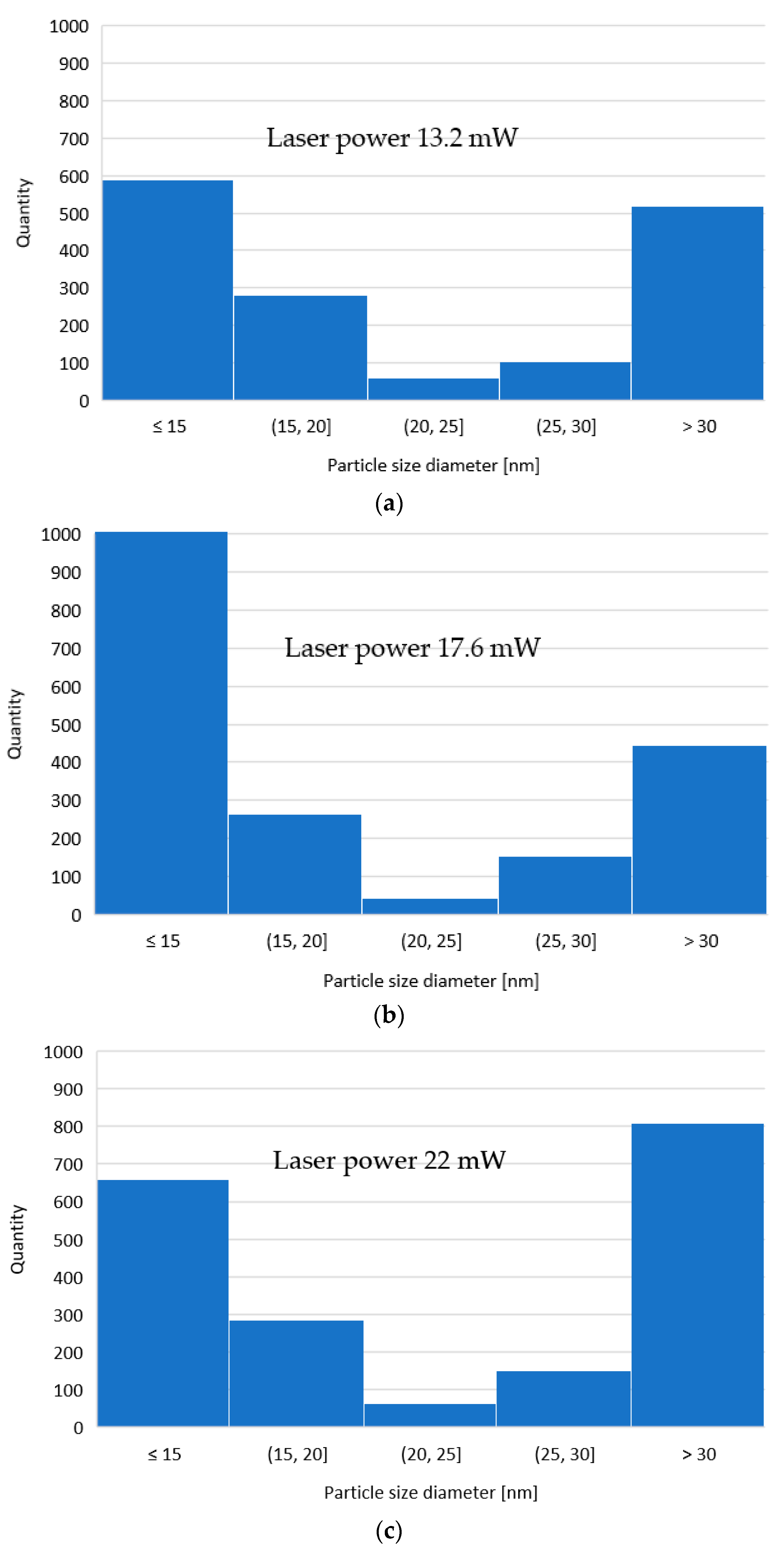
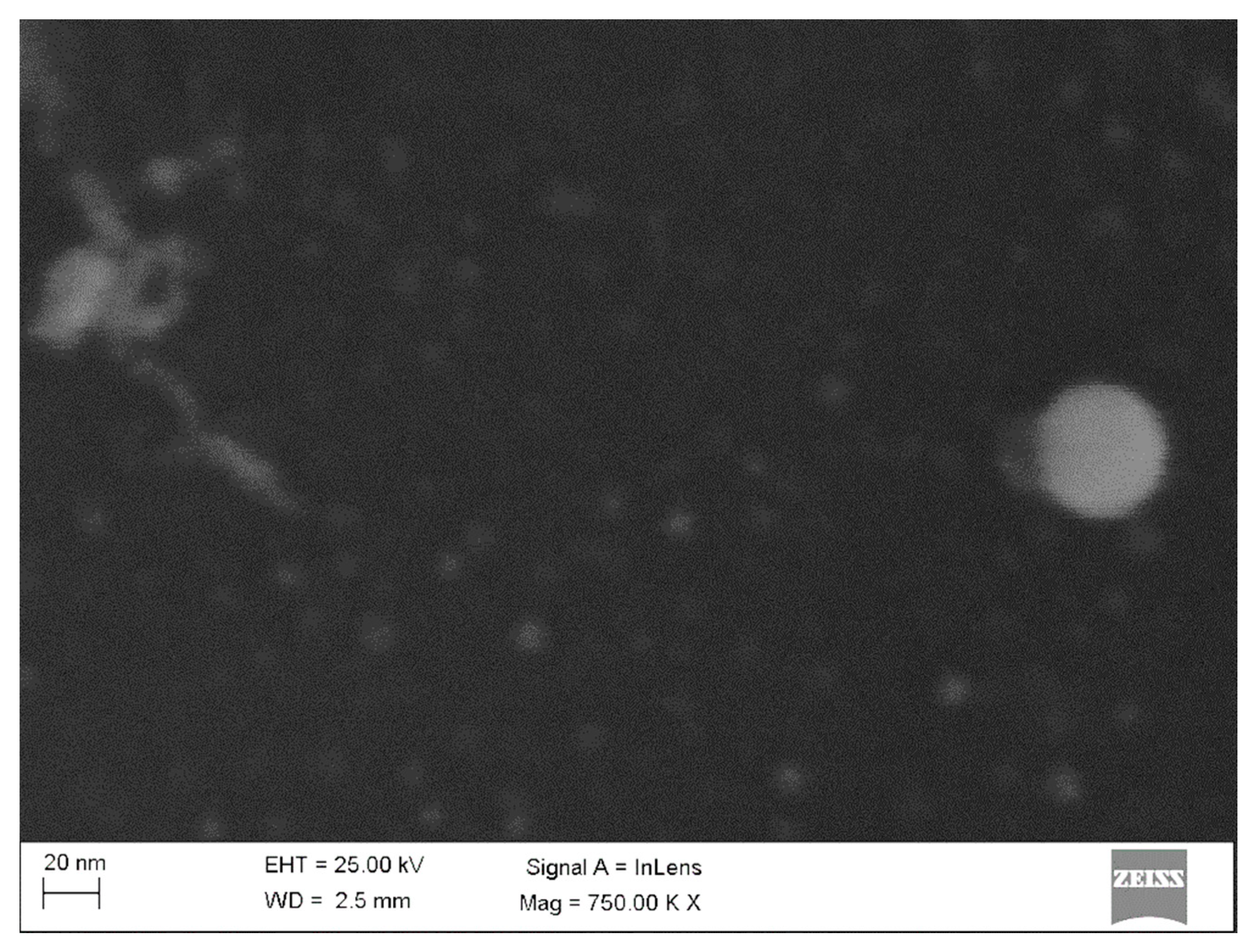
| Ti | Fe | O | C | N | H | |
|---|---|---|---|---|---|---|
| 99.65 | 0.02 | 0.18 | 0.10 | 0.0096 | 0.0290 | |
| Surface Treatment | |||||
|---|---|---|---|---|---|
| Surface Condition | Laser Power, mW | Texturing Speed | Frequency | Beam Width | M2 |
| Polished, Au coated | 4.4 | 1 mm/s | 400 Hz|10 Hz | ~30 µm | <1.2 |
| 8.8 | |||||
| 13.2 | |||||
| 17.6 | |||||
| 22 | |||||
Publisher’s Note: MDPI stays neutral with regard to jurisdictional claims in published maps and institutional affiliations. |
© 2021 by the authors. Licensee MDPI, Basel, Switzerland. This article is an open access article distributed under the terms and conditions of the Creative Commons Attribution (CC BY) license (https://creativecommons.org/licenses/by/4.0/).
Share and Cite
Bialas, O.; Poloczek, T.; Lis, M.; Skowronek, A.; Górka, J.; Adamiak, M. Laser Assisted Size Reduction of Gold (Au) Particles onto a Titanium (Ti) Substrate Surface. Appl. Sci. 2021, 11, 8755. https://doi.org/10.3390/app11188755
Bialas O, Poloczek T, Lis M, Skowronek A, Górka J, Adamiak M. Laser Assisted Size Reduction of Gold (Au) Particles onto a Titanium (Ti) Substrate Surface. Applied Sciences. 2021; 11(18):8755. https://doi.org/10.3390/app11188755
Chicago/Turabian StyleBialas, Oktawian, Tomasz Poloczek, Mateusz Lis, Adam Skowronek, Jacek Górka, and Marcin Adamiak. 2021. "Laser Assisted Size Reduction of Gold (Au) Particles onto a Titanium (Ti) Substrate Surface" Applied Sciences 11, no. 18: 8755. https://doi.org/10.3390/app11188755
APA StyleBialas, O., Poloczek, T., Lis, M., Skowronek, A., Górka, J., & Adamiak, M. (2021). Laser Assisted Size Reduction of Gold (Au) Particles onto a Titanium (Ti) Substrate Surface. Applied Sciences, 11(18), 8755. https://doi.org/10.3390/app11188755









